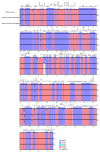The Complete Chloroplast Genome Sequencing and Comparative Analysis of Reed Canary Grass (Phalaris arundinacea) and Hardinggrass (P. aquatica)
- PMID: 32545897
- PMCID: PMC7356517
- DOI: 10.3390/plants9060748
The Complete Chloroplast Genome Sequencing and Comparative Analysis of Reed Canary Grass (Phalaris arundinacea) and Hardinggrass (P. aquatica)
Abstract
There are 22 species in the Phalaris genera that distribute almost all over the temperate regions of the world. Among them, reed canary grass (Phalaris arundinacea, tetraploid and hexaploid) and hardinggrass (P. aquatica, tetraploid) have been long cultivated as forage grass and have received attention as bio-energy materials in recent years. We aimed to facilitate inter-species/ploidies comparisons, and to illuminate the degree of sequence variation within existing gene pools, chloroplast (cp) genomes of three Phalaris cytotypes (P. aquatica/4x, P. arundinacea/4x and P. arundinacea/6x) were sequenced and assembled. The result indicated that certain sequence variations existed between the cp genomes of P. arundinacea and P. aquatica. Several hotspot regions (atpI~atpH, trnT-UGU~ndhJ, rbcL~psaI, and ndhF~rpl32) were found, and variable genes (infA, psaI, psbK, etc.) were detected. SNPs (single nucleotide polymorphisms) and/or indels (insertions and deletions) were confirmed by the high Ka/Ks and Pi value. Furthermore, distribution and presence of cp simple sequence repeats (cpSSRs) were identified in the three Phalaris cp genomes, although little difference was found between hexaploid and tetraploid P. arundinacea, and no rearrangement was detected among the three Phalaris cp genomes. The evolutionary relationship and divergent time among these species were discussed. The RNA-seq revealed several differentially expressed genes (DEGs), among which psaA, psaB, and psbB related to leaf color were further verified by leaf color differences.
Keywords: Phalaris aquatica L.; Phalaris arundinacea L.; RNA-seq; chloroplast genome; high-throughput sequencing; ploidy.
Conflict of interest statement
The authors declare that they have no competing interest.
Figures








Similar articles
-
Complete chloroplast genomes of three wild perennial Hordeum species from Central Asia: genome structure, mutation hotspot, phylogenetic relationships, and comparative analysis.Front Plant Sci. 2023 Jul 24;14:1170004. doi: 10.3389/fpls.2023.1170004. eCollection 2023. Front Plant Sci. 2023. PMID: 37554563 Free PMC article.
-
Transcriptome characterization and differentially expressed genes under flooding and drought stress in the biomass grasses Phalaris arundinacea and Dactylis glomerata.Ann Bot. 2019 Oct 29;124(4):717-730. doi: 10.1093/aob/mcz074. Ann Bot. 2019. PMID: 31241131 Free PMC article.
-
Variation in sequences containing microsatellite motifs in the perennial biomass and forage grass, Phalaris arundinacea (Poaceae).BMC Res Notes. 2016 Mar 22;9:184. doi: 10.1186/s13104-016-1994-6. BMC Res Notes. 2016. PMID: 27005474 Free PMC article.
-
Greater seasonal carbon gain across a broad temperature range contributes to the invasive potential of Phalaris arundinacea (Poaceae; reed canary grass) over the native sedge Carex stricta (Cyperaceae).Am J Bot. 2011 Jan;98(1):20-30. doi: 10.3732/ajb.1000179. Epub 2010 Dec 2. Am J Bot. 2011. PMID: 21613081
-
Accumulation and distribution of macroelements in the organs of Phalaris arundinacea L.: Implication for phytoremediation.J Environ Sci Health A Tox Hazard Subst Environ Eng. 2014;49(12):1385-91. doi: 10.1080/10934529.2014.928494. J Environ Sci Health A Tox Hazard Subst Environ Eng. 2014. PMID: 25072770
Cited by
-
Complete plastomes of six species of Wikstroemia (Thymelaeaceae) reveal paraphyly with the monotypic genus Stellera.Sci Rep. 2021 Jun 30;11(1):13608. doi: 10.1038/s41598-021-93057-3. Sci Rep. 2021. PMID: 34193929 Free PMC article.
-
Herbicide Resistance in Phalaris Species: A Review.Plants (Basel). 2021 Oct 21;10(11):2248. doi: 10.3390/plants10112248. Plants (Basel). 2021. PMID: 34834611 Free PMC article. Review.
-
Complete chloroplast genomes of three wild perennial Hordeum species from Central Asia: genome structure, mutation hotspot, phylogenetic relationships, and comparative analysis.Front Plant Sci. 2023 Jul 24;14:1170004. doi: 10.3389/fpls.2023.1170004. eCollection 2023. Front Plant Sci. 2023. PMID: 37554563 Free PMC article.
-
Complete Chloroplast Genomes of 14 Subspecies of D. glomerata: Phylogenetic and Comparative Genomic Analyses.Genes (Basel). 2022 Sep 9;13(9):1621. doi: 10.3390/genes13091621. Genes (Basel). 2022. PMID: 36140789 Free PMC article.
References
-
- Ravi V., Khurana J.P., Tyagi A.K., Khurana P. An update on chloroplast genomes. Plant Syst. Evol. 2008;271:101–122. doi: 10.1007/s00606-007-0608-0. - DOI
Grants and funding
LinkOut - more resources
Full Text Sources
Research Materials
Miscellaneous

